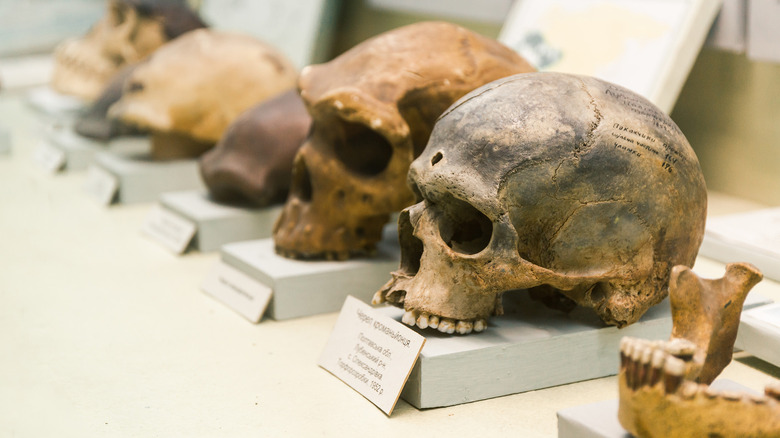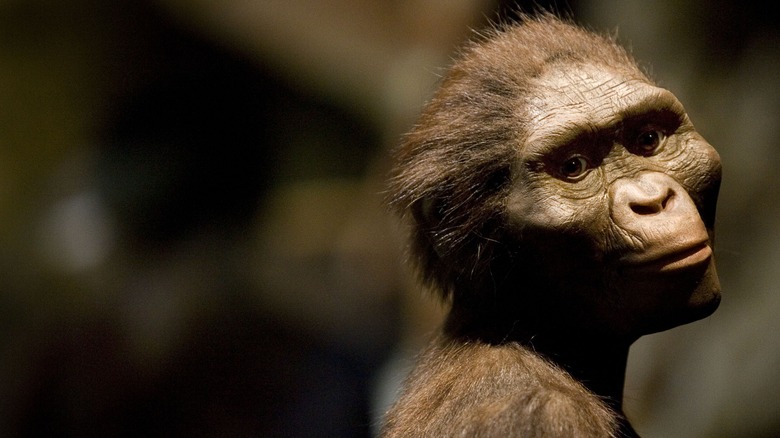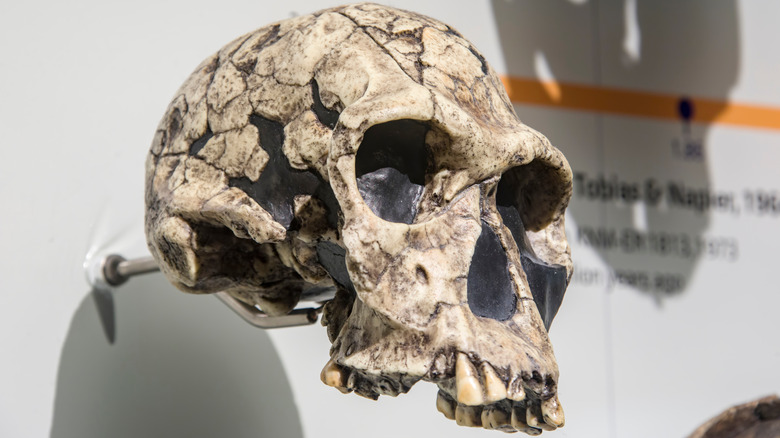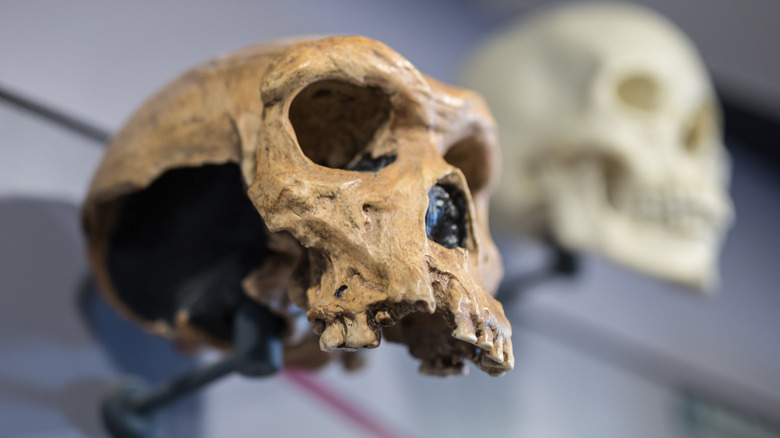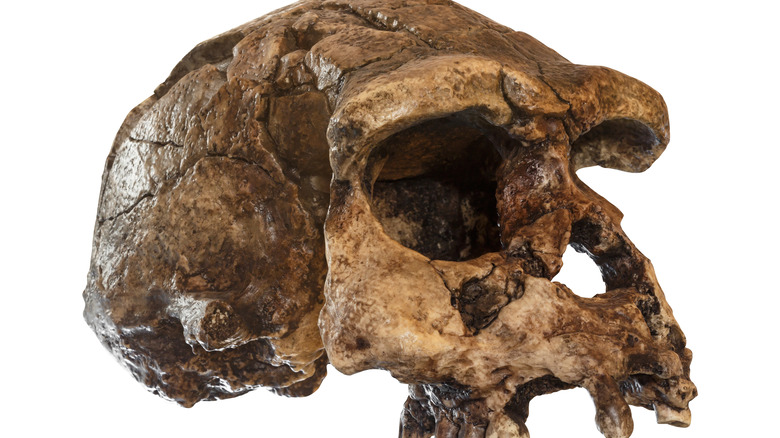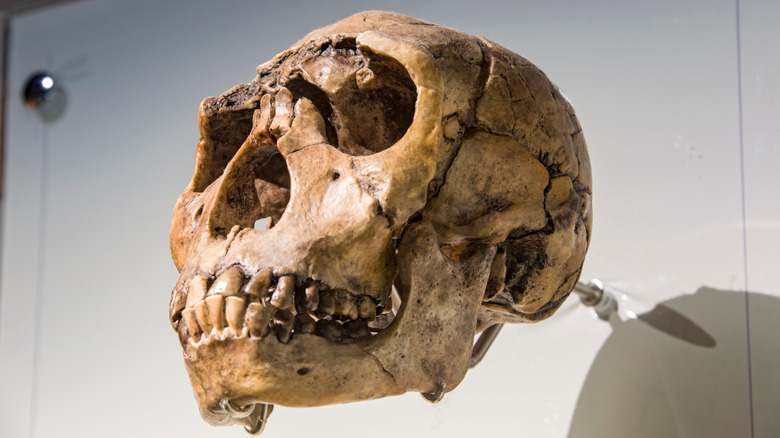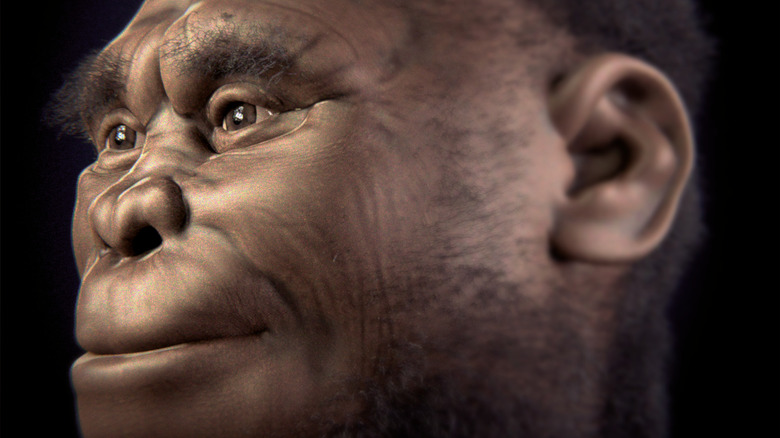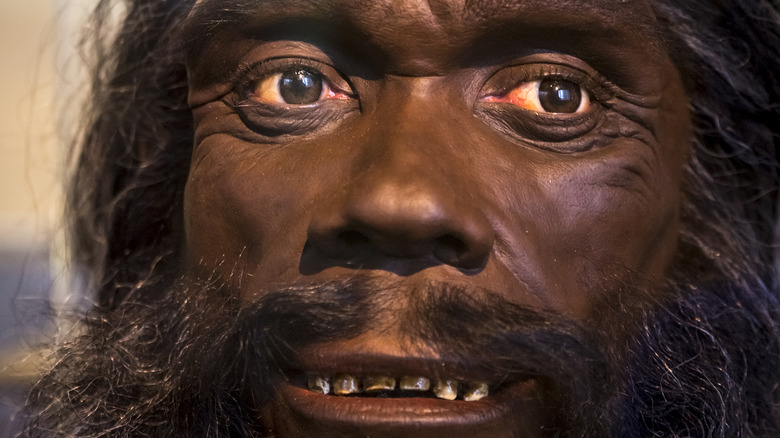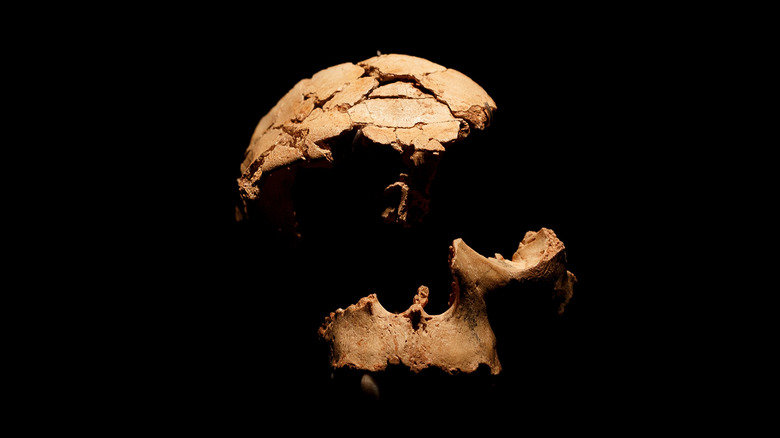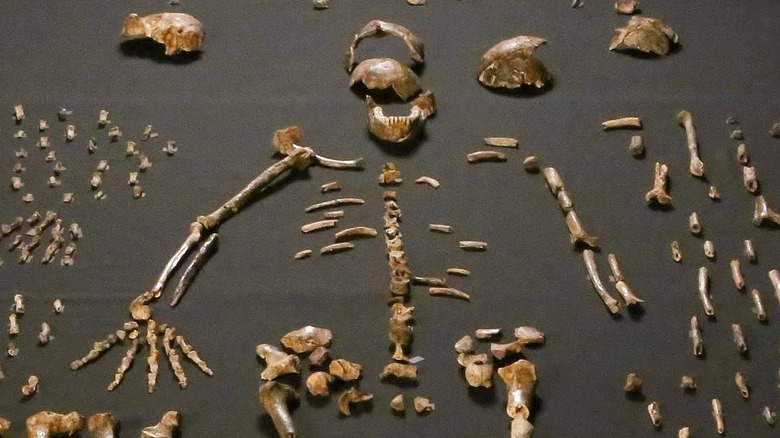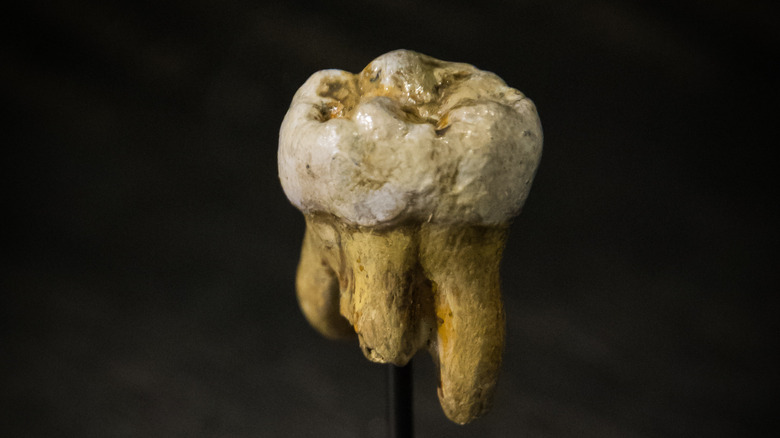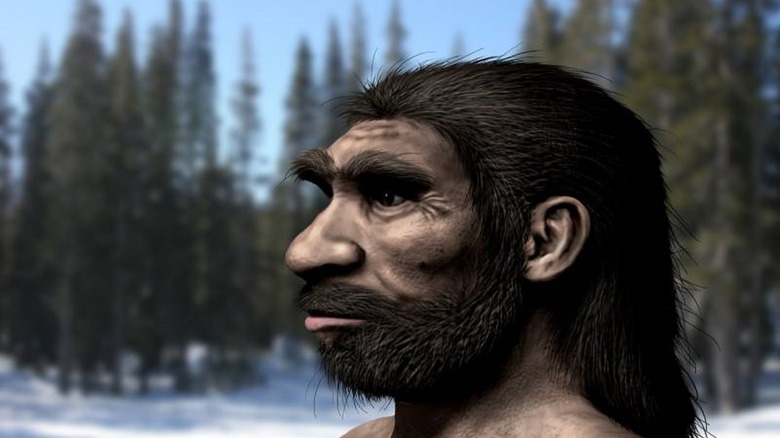12 Types Of Extinct Human Species And How They Differ
Today, Homo sapiens are the only type of humans on Earth. However, we modern humans are just the most recent of many other human species that once existed. In fact, we don't know how many species, since scientists keep on finding new species of human. As Britannica explains, the forerunners to humans diverged from apes during the Middle Miocene Epoch from 16 to 11.6 million years ago. These nearly-human species then evolved so that by the Pliocene Epoch some 5.3 to 2.6 million years ago, the human genus, Homo, arose.
Species of human are considered distinct by several traits. They are bipedal striders. They generally have large brains. Some also developed tools and use language. These traits became more pronounced as humans evolved further.
What is truly mind blowing is that there were times when there were several different species of human cohabitating the planet. When considering how well we humans of the same species get along with each other, it is not hard to speculate on how intra-human species relations were.
Let's take a look at some of these species of extinct humans and how they differed with one another. The truth of the matter is that the human species was once very diverse.
Australopithecus afarensis
While strictly speaking not of the genus Homo, Australopithecus represents the immediate ancestors of humans. There were several Australophithecus species but perhaps the best known is Australopithecus afarensis, which lived, according to London's Natural History Museum, between 3.7 to 3 million years ago. This fame is related to the discovery of an Australopithecus afarensis skeleton nicknamed Lucy in 1974. It was reportedly named after the Beatles song "Lucy in the Sky with Diamonds."
Afarensis were tiny. Their height ranged from between 3 feet, 2 inches to 5 feet, 5 inches with a weight of between 55 to 141 pounds. Notably, afarensis males were much larger than females. Afarensis had small brains too. A very large brained afarensis could have up to 550 cubic centimeters of gray matter. In comparison, Livescience explains that modern human brains average 1,274 and 1,131 cubic centimeters for males and females, respectively.
Afarensis lived in East Africa, with fossils having been found in Ethiopia, Tanzania, and Kenya. There, they lived a vegetarian lifestyle in trees and on the ground. While they could walk upright, they were not fully adapted for long-distance travel on two feet. Their faces were also more ape-like than human-like, with a forward jutting jaw.
When considering that afarensis lived for 700,000 years before going extinct, it is obvious to conclude that the species was a highly successful one.
Homo habilis
About 2.5 million years ago, the global climate began to cool. "Origin of the Genus Homo," asserts that this may have been the spark that caused an Australopithecus species to evolve into the first human species. The earliest known of these is Homo habilis, which lived from approximately 2.3 to 1.4 million years ago in East and South Africa. Unlike the preceding australopithecus species, Habilis had completely evolved for a bipedal lifestyle. They also had larger brains at over 600 cubic centimeters.
Habilis were shaped differently, too. Their skulls were smoother and rounder compared to australopithecus, their faces projected less, and their teeth were smaller and narrower. Still, habilis were small compared to modern humans, averaging about 75 pounds. Their diet, as told by the Smithsonian, included hard to chew foods like woody plants. Habilis also ate meat, which is known because of tool and bone evidence. In fact, this species' name, Homo habilis, literally means "handy man." At the time of their discovery in 1964, it was thought that they were the earliest users of tools. However, it has been shown that australopithecus species may have been using tools earlier.
Homo habilis is often put forward as the ancestor of all other human species.
Homo rudolfensis
Ancient human fossils are rare, so when new fossils are found, it opens the door for controversy and debate. This is because fossils are usually never complete, which leads to different scientific interpretations. There are thousands of ways you can interpret a single molar.
Such is the case with Homo rudolfensis. As summarized by the "Origin of the Genus Homo," this species is understood from a single cranium discovered in the Turkana Basin in Kenya and a mandible in Malawi. The skull could hold a brain of 752 cubic centimeters, which is significantly larger than habilis. Also, the teeth sockets indicate that their teeth were large. This evidence has led scholars to classify this finding as a separate species from Homo habilis.
Yet because the evidence is so fragmentary, the classification of Homo rudolfensis has been difficult. The Australian Museum reports that some scientists view rudolfensis as being part of the genus Homo while others think it is more closely tied to the australopithecus species, just with a larger brain. However, it is agreed that rudolfensis lived approximately 1.7 million years ago and thus would have coexisted with Homo habilis and Homo erectus. The questions about rudolfensis are likely to continue unless new discoveries are made
Homo erectus
Homo erectus is well-known because a number of specimens of the species have been excavated. These date from between 1.89 million to 110,000 years ago, making it the longest existing species of human ever.
According to the "Origin of the Genus Homo," erectus had larger bodies and smaller teeth than Homo habilis. Also differentiating them from earlier human species were their proportions. The Smithsonian reports that erectus had the shorter arms and longer legs of a proportional modern human. Also, their height was comparable, ranging from 4 feet, 9 inches to just over 6 feet with an upward average weight of 150 pounds. Erectus were fully evolved to live a ground-based lifestyle.
What really differentiated erectus from earlier human species was brain size. Erectus' braincase ranged from 700 to 1,300 cubic centimeters. Since brains take up a lot of energy, erectus ate meat as well as plants. Erectus also used diverse tools that included handaxes and cleavers.
There were a couple of significant firsts for humans with erectus. First, it is likely that they were the first to use and control fire. Second, erectus was the first human to leave the African continent. Fossils of erectus have been found also in all parts of Asia, even as far east as Indonesia. It is likely that a population of erectus gave rise to the lineage of modern Homo sapiens.
Homo ergaster
One of the most debated human fossil finds is that of a Homo ergaster. As explained by Science Daily, this species of human roamed eastern and southern Africa between 1.9 and 1.4 million years ago.
The argument over ergaster is whether it is its own separate species or if it is in fact just a subspecies of Homo erectus. Many sources, such as the Smithsonian, just lump ergaster and erectus together. Others, such as Michigan State University, state that ergaster may have been the direct ancestor of erectus or that ergaster was just the version of erectus that lived in Africa. Another related controversy is whether ergaster or erectus gave rise to the lineage that produced modern humans.
Because of the timeline, ergaster would have lived at the same time as erectus. However, ergasters were more slender with thinner skull bones, while erectus were more robust. Ergasters, like erectus, used tools and presumably had a similar lifestyle.
Homo floresiensis
In 2003, on the island of Flores in Indonesia, scientists made a remarkable discovery in the Liang Bua cave. As told by National Geographic, they found the remains of humans that stood about 3.5 feet tall and weighed at maximum 75 pounds, though the females could be as light as 35 pounds. This species of human was dubbed Homo floresiensis after the island, but they were quickly nicknamed hobbits. Smithsonian reports that this particular human species lived 100,000 to 50,000 years ago.
Floresiensis were diminutive. Their brains were about 426 cubic centimeters, which is a little over a third of the size of a modern human brain. Despite the small brain, floresiensis used weapons to hunt stegodon, a type of extinct pygmy elephant.
What scientists are trying to figure out is how floresiensis fits into the homo family tree. Some reason that floresiensis descended from Homo erectus and evolved into dwarfs, as many species do in island environments. Others, as reported by Live Science, have posited that they were modern humans who suffered from mutations. Yet this is countered by skeletal differences, such as a lack of a chin, in floresiensis. Other analysis suggests that floresiensis evolved from a different human species than erectus, which means that erectus would not have been the first human to migrate out of Africa. The debate will likely only continue as more research and excavation is done.
Homo heidelbergensis
A possible ancestral species of modern humans is Homo heidelbergensis. As detailed by Britannica, information about this species is known from fossils dating from between 600,000 to 200,000 years ago. Heidelbergensis lived in eastern and southern Africa, Europe and possibly as far away as China.
Heidelbergensis was different than earlier human species since it was the first to be adapted to the cold. These humans had flatter faces than their predecessors, prominent brow ridges and broad bodies which reached up to 5 feet, 9 inches in males. Heidelbergensis also had brains that measured 1,250 cubic centimeters, as described by the Australian Museum. This species also was technologically advanced. According to Smithsonian, they had mastery over fire, which is shown by the presence of hearths and fireplaces. They also could build shelters, as well as more advanced weapons like spears. One site in Spain shows that this species may have conducted rituals, indicated by numerous bodies that seem to have been deliberately thrown in a pit.
Some scientists theorize that Homo heidelbergensis was the direct ancestor of modern humans and their close cousins, Neanderthals.
Homo antecessor
Homo antecessor is a debated human species. As detailed by the Australian Museum, the first remains of antecessor were uncovered by archaeologists between 1994 and 1996 in Atapuerca, Spain. Subsequent discoveries, also in Spain, have led scientists to date the species from 800,000 to 1.2 million years ago. This species was different from other human species, with a selection of traits that clearly show that it was related to modern humans. What were those traits?
The brain size of antecessor, while large at 1,000 cubic centimeters, was not particularly remarkable. Its height, which ranged from 5 feet, 2 inches to 5 feet, 9 inches made it very comparable to Homo heidelbergensis, as well as modern humans. Antecessor is thought to have led a hunting lifestyle with large amounts of weapons and tools found at dig sites.
Antecessors' facial features were definitely more modern, including projecting noses and modern cheek bone structure. However, they also had prominent brow ridges and a receding chin, features seen in other species of human. All the same, these facial features, according to Britannica, have let some scientists to classify antecessor as its own species. Smithsonian reports that some have argued that this species might have been the direct ancestor of modern humans, hence its name. However, some view Homo antecessor as merely a type of Homo heidelbergensis. It is likely that the matter will not get settled until more specimens are found.
Homo naledi
One of the largest archaeological findings of extinct humans was in the Rising Star Cave System in South Africa. According to Smithsonian, over 1,550 fossils representing 15 individual humans were recovered from the cave's Dinaledi chamber. This species was dubbed Homo naledi.
Naledi lived from approximately 335,000 to 236,000 years ago. Curiously, naledi has many shared traits with Australopithecines, such as the pelvis and shoulder. These are mixed with human traits, such as its hands and feet. More intriguing is the brain. While Homo naledi's brain size was small, being reported by Arstechnica at no larger than 600 cubic centimeters, it was structured and shaped like a modern human brain. What this indicates is that brain size may not matter as much as how it is organized.
There are many unanswered questions about naledi. The Australian Museum details that there is no evidence of them using tools or fire. Neither it is unclear what they ate, though marks on teeth suggest much erosion by grit. Also unresolved is Homo naledi's relative place in the human genus. Did naledi exist by itself for millions of years unchanged? Is it an offshoot of Homo erectus or is it related to modern humans? If answers are to be found, they are still buried in the ground.
Homo Neanderthalensis
The most well-known of all extinct humans is Homo Neanderthalensis, known popularly as Neanderthals (sometimes spelled Neandertals). These are usually considered stereotypical "cavemen." According to Britannica, Neanderthals first came on the scene about 200,000 years ago and lived until as recently as 24,000 years ago.
The Smithsonian explains that Neanderthals are probably the closest extinct relative to modern humans. Neanderthals were smaller than modern humans, with males being about 5 feet, 5 inches tall at 143 pounds and females 5 feet, 1 inch tall at 119 pounds. However, they were more robustly built, stronger, and had prominent noses. All of these were adaptations for the cold since Neanderthals lived from Western Europe to Central Asia during the Ice Ages. To cope with these conditions, they had a slate of advanced weapons and tools for hunting, gathering, and making clothes and shelter. This intelligence is reflected in their brain size, which according to Discover Magazine was about 1,410 cubic centimeters — larger than modern human brains. Neanderthals also displayed culture, through what appears to be formal burials, evidence of spiritual beliefs, and even possibly musical instruments. Archaeologists found what is possibly a flute at a Neanderthal dig site.
The reason Neanderthals went extinct is debated, although it is likely they were pushed out by modern humans. Still, recent genetic analysis shows that Neanderthals interbred with modern non-African humans. So in a way, Neanderthals never really went extinct.
Denisovans
Very closely related to Neanderthals and modern humans are Denisovans. As reported by the New York Times, this species is a recent finding from a cave in Siberia in 2010. The initial findings, just a bit of a pinky bone and a wisdom tooth, seemed paltry. Soon, other fragments appeared, mainly teeth and a jaw bone. However, according to Nature, scientists were able to extract enough genetic material from these miniscule raw materials to give us a picture of this species of human. The working theory is that about 400,000 years ago, Denisovans branched off from Neanderthals and that instead of migrating to Europe, they moved through Asia.
Denisovans were similar to Neanderthals in appearance, having broad chests and low foreheads, but differed with wider skulls and jawbones. National Geographic reported that like Neanderthals, Denisovans interbred with modern humans. For the Denisovans, this took place in New Guinea until at least 30,000 years ago but potentially as recently as 15,000 years ago. If this is true, then Denisovans were the last other human species to become extinct.
Homo longi
Homo longi was first discovered as a nearly complete skull in northeastern China in 1933. However, according to Discover Magazine, it was treated no more than a curiosity. The skull was larger than modern humans and the brain size seemed to be comparable. Sci News reports that the skull also featured nearly square eye sockets and thick brow ridges.
However, no one worked out the puzzle of this skull until 2021, when researchers proposed that it was a new, unique human species. What's more, this specimen was alive, at minimum, 146,000 years ago. Analysis also makes scientists believe that this particular skull belonged to a 50-year-old male living in a community in a forested floodplain. Some scientists contend that this species would be the closest extinct relative to modern humans. However, as the New Scientist points out, this claim is highly contested, with others believing that Homo longi is a Denisovan. More specimens would need to be recovered and compared to determine if this is truly a new species.
